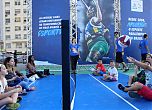
Capoeira was developed as a form of self-defence by African slaves in the Brazilian plantations from as early as the Sixteenth Century. A way to disguise fighting and training as a traditional dance, complete with a circle of musicians surrounding them, it is still practised in exactly the same way today. Though its spiritual home is Bahia, Rio holds numerous schools headed up by mestres of the art, most of whom welcome newcomers and those brave enough to go toe-to-toe with the lithe young things who have been doing it since they could walk. Impromptu street performers can be found around Ipanema and Arpoador, but for the best experience if you hear the hypnotic twang of the berimbau instrument as you walk along the street, follow it indoors and you will stumble upon a class in progress. Far from getting in the way, you will likely witness their efforts redoubled to show just what they can do.
Lapa
www.lapariocapoeira.com
Copacabana
www.abadacapoeirabp.blogspot.com
Jacarepagua
www.capoeirarj.com



